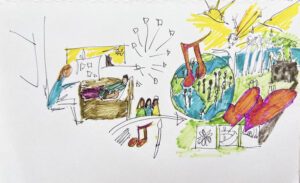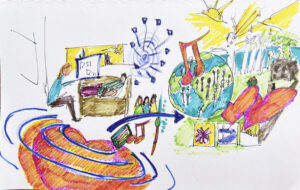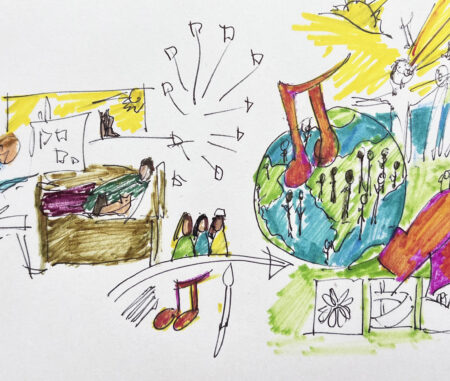Impact Investing
About 10 years ago Rebecca’s little sister Julia who’d been working in the world of finances decided to pursue a master’s degree in Impact Investing—investing into business that has positive social and environmental impact. At the time, studying this subset of the financial markets was virtually unheard of and, for those who did know of it, it was considered at best risky, at worst, a losing proposition. Regardless, rarely a profitable one.
Impact Investing is Now Profitable
As global warming has gone from a distant abstraction into real world changes and “green” efforts have become financial opportunities, impact investing has finally gained momentum. So, for those people who have the privilege of being able to invest their money in ways that have positive impact, they can now actually make a profit.
What Keeps Us From Impact Investing?
But what about the rest of the us that either don’t have the means, the know-how, or the risk tolerance to engage in any investing, let alone impact investing?! This is what first crossed Rebecca’s mind when Julia asked her to run a workshop on the topic for a group of Julia’s friends and colleagues. She wanted to help them bridge their desire to invest in ways that had more positive impact with whatever kept them from acting on those aspirations. Rebecca’s second thought, then, was, “how on earth do we address that with art?”
What Do We Invest In?
As Rebecca and Julia fleshed this out, it occurred to them that we are always “investing” resources—time, money, attention, effort—into that which we feel is either important or urgent. So we started the workshop by making a list of where we were devoting our resources (friends, family, work, exercise, hobbies & interests, distractions, bad habits, etc.). Then we listed what it would look like if we were channeling our resources in ways that had positive impact—on ourselves, the people in our lives, in our communities, etc.
The Art Exercise
For the art part, we divided a piece of drawing paper and drew symbols for those two domains–what it looks like now and how we’d like it to be—and then included what would bridge the two realms.
Take Aways
In the end, what emerged for everyone what that they were already “investing” more than they realized into what was important to them. They could also see tangible ways they could be diverting their resources toward having more positive impact both personally and on the environment.
Rebecca Tries It Out


Rebecca tried the exercise out herself and, as always happens, it was helpful to get her thoughts from floating around in her mind and onto paper. Also to see what metaphors emerged and what they might mean. For example, she noticed that she hadn’t put anything in the lower part of the left side, things seemed to be floating, so she added a large heart as a foundation for the piece. She also wanted to put more details into the arrow that bridges the left to the right side. That seemed key.
More Insights
She then realized that the arrow was the same color of blue as the spiral radiating from the heart, a color that for her represents spirituality. That made sense as well.
Showing It To Others
When Rebecca showed it to some other people, they noticed many things that she hadn’t and, as usual, it was surprising how different they perceived some elements in contrast to what she had intended. For example, she had meant her figure in the “now” section on the left to be typing on a keyboard and looking at a computer but to others it appeared as if her figure was pointing at the person on the couch. They didn’t see the “computer” at all. They had also assumed that person on the couch must be a therapy client. Rebecca is, after all, a therapist, and, cliché as it may be, clients are traditionally associated with lying on couches! Although Rebecca had initially intended the figure to be her husband relaxing with their cats, it gave her pause to wonder “If that were my clients, and I am pointing at them, what does that mean?”
Other Observations
They also noticed that the hearts and the music were in the same colors. That was no surprise. What was interesting was that the blue spiral in the top with radiating arrows which Rebecca had intended to represent the sense that she feels scattered and pulled by too many projects is also in that deep blue. She took that to mean that, although it often feels overwhelming to be involved in so many things, it is driven by her passion and mission in life—to share the importance of art with the world. There are many more insights she will continue to get from this piece as she continues to reflect on and even make changes to it.
Try This Yourself
We recommend you try this exercise out yourself. Here are the full instructions:
- Take a piece of writing paper and make two columns.
- Title the first “How I invest my time, energy, effort, and attention now”.
- Title the second column “How I would like to be devoting those resources to have more positive impact both on myself, others, and the environment”.
- List your thoughts and responses in the two columns.
- Fold a piece of art paper of any size in half.
- On the left side, capture what you wrote in the first column. You can draw stick figures or include symbols, collage, etc.
- On the right side do the same for the second column.
- Then depict (again using symbols or cut out images) what would bridge the two domains.
- Spend some time developing your images.
- Step back and take a look at it.
- Are there changes that you would make? Areas that you might develop more?
- If you are going to make changes, take a snapshot of it with your phone so you can compare it at this moment to the final version.
- Make any of those changes now if you would like.
- Show it to someone else and see what they observe.
- Does it differ from what you intended and does that give you any further insights?
- How does this exercise effect how you are investing your resources?
Do this art activity with others and see how they “interpret” the exercise and how they approach their “investments” in life differently.
Learn More About Impact Investing
Also, if you want to learn more about , visit Julia’s website to find lots of free resources on the topic.
